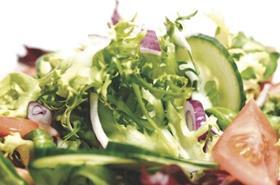
Diners are willing to pay three times more for a salad if it is carefully arranged on the plate.
That's according to a new study commissioned by Lidl and carried out for the discount retailer by an Oxford University professor.
Charles Spence, a professor of experimental psychology, said: 'We can often put all our effort into the cooking of the food and then perhaps undo ourselves when it comes to presenting it on the plate.
'It may seem a lot to ask but our research reveals that plating up the dish in a slightly more intricate manner can positively affect the taste of the dish.'
Professor Spence asked more than 130 people to taste a salad and steak and chips presented in three different ways.
Despite the ingredients being exactly the same, the salad in which the cucumber had been sliced in thin strips was deemed tastiest.
And the volunteers said they would pay three times as much for it as for a homely one in which the salad had simply been tossed before being put on the plate.
The steak, meanwhile, was most appealing when placed in the centre of the plate, rather than at the edge.
Lidl’s Kevin Love, a Michelin-starred chef and former store manager, advises serving odd numbers of items.
According to Love, despite being a smaller portion, three scallops or broccoli florets is preferred to four.
Another tip, already employed by many expensive restaurants, is not to overload the plate.
Apparently, food seems more attractive when it is placed in the centre of the dish and circled by a ‘frame’ of empty china.
Love said: 'When it comes to the dinner debate, I think many of us know that attention to presentation makes a difference but were perhaps unaware of the extent.
'This experiment has highlighted that consideration of how you serve dishes has a huge impact on taste perceptions.The fact people are willing to pay three times as much is staggering.'



